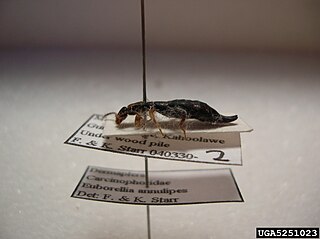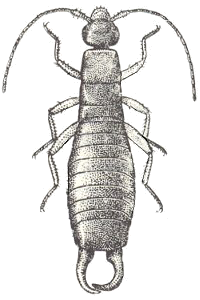
Earwigs make up the insect order Dermaptera. With about 2,000 species in 12 families, they are one of the smaller insect orders. Earwigs have characteristic cerci, a pair of forcep-like pincers on their abdomen, and membranous wings folded underneath short, rarely used forewings, hence the scientific order name, "skin wings". Some groups are tiny parasites on mammals and lack the typical pincers. Earwigs are found on all continents except Antarctica.

The pungent pipistrelle is a species of vesper bat in the family Vespertilionidae. It is found in Indonesia and possibly the Philippines.

Anisolabididae is a family of earwigs, in the suborder Neodermaptera and the order Dermaptera.

Anisolabidinae, alternatively known as Carcinophorinae, Gonolabiinae, or Placolabidinae, is a subfamily of earwigs containing 17 genera.
Aborolabis is a genus of earwigs in the subfamily Anisolabidinae. It was cited by Srivastava in Part 2 of Fauna of India.

An anchovy is a small, common forage fish of the family Engraulidae. Most species are found in marine waters, but several will enter brackish water, and some in South America are restricted to fresh water.
Aborolabis mauritanica is a species of earwig in the genus Aborolabis, the family Anisolabididae, and the order Dermaptera. Found primarily in the Palearctic realm, but also in parts of the Afrotropical realm, this species was discovered by Hippolyte Lucas in 1846.
Aborolabis cerrobarjai is a species of earwig in the genus Aborolabis, the family Anisolabididae, and the order Dermaptera.
Aborolabis angulifera is a species of earwig in the genus Aborolabis, the family Anisolabididae, and the order Dermaptera. Primarily found in the Afrotropical realm, this species was discovered by Dohrn in 1864.
Aborolabis emarginata is a species of earwig in the genus Aborolabis, the family Anisolabididae, and the order Dermaptera.
Aborolabis kalaktangensis is a species of earwig in the genus Aborolabis, the family Anisolabididae, and the order Dermaptera.
Aborolabis martensi is a species of earwig in the genus Aborolabis, the family Anisolabididae, and the order Dermaptera.
Aborolabis nepalensis is a species of earwig in the genus Aborolabis, the family Anisolabididae, and the order Dermaptera.
Aborolabis pervicina is a species of earwig in the genus Aborolabis, the family Anisolabididae, and the order Dermaptera. Found primarily in the Indomalayan realm, this species was first classified by Burr in 1913.
Aborolabis nigrescens is a species of earwig in the genus Aborolabis, the family Anisolabididae, and the order Dermaptera.
Aborolabis rufocapitata is a species of earwig in the genus Aborolabis, the family Anisolabididae, and the order Dermaptera.
Aborolabis tanzanica is a species of earwig in the genus Aborolabis, the family Anisolabididae, and the order Dermaptera.
Aborolabis vicina is a species of earwig in the genus Aborolabis, the family Anisolabididae, and the order Dermaptera. Found primarily in the Afrotropical realm, this species was first classified by Burr in 1911.

Anisolabis maritima, commonly known as the maritime earwig or the seaside earwig, is a species of earwig in the family Anisolabididae. Similar to the seashore earwig, this species can be found near the shore line, and is cosmopolitan. It can be found in almost all biogeographic realms. Scientists believe that these earwigs originally came from Asia. Since then, however, they have been introduced to North America, and have now spread around the world due to international commerce.
A. nepalensis may refer to:




